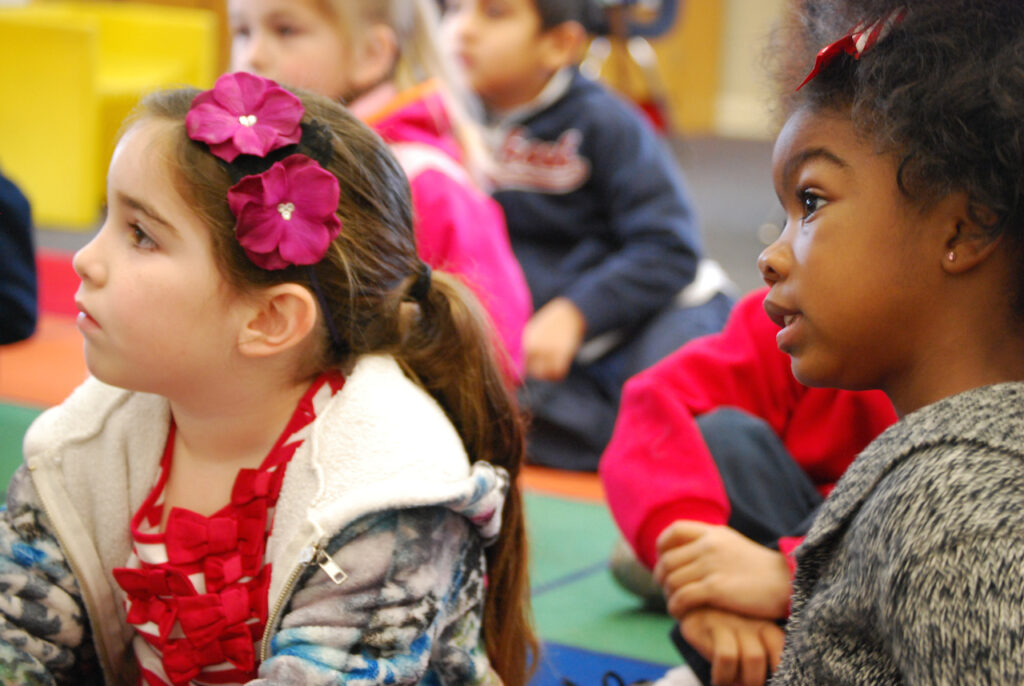 Credit: Lillian Mongeau/EdSource Today
Credit: Lillian Mongeau/EdSource Today Credit: Lillian Mongeau/EdSource Today
Credit: Lillian Mongeau/EdSource TodayDeclining school enrollment seems to be a fact of life in California’s TK-12 system. However, one of the few bright spots in the picture is kindergarten enrollment, including TK, or transitional kindergarten, which altogether rose nearly 26,000 to 496,000 students over the past year. It is now the biggest cohort among all the grades.
And yet even there, the numbers fall short of projections. State officials had predicted the average daily attendance of students in TK would be 120,000 but as of the first half of the year, it was only 91,000, according to reports filed at the California Department of Education.
That’s about 29,000 less than projected in TK. It used to serve only the children who just missed the kindergarten cutoff, but transitional kindergarten now is being gradually expanded to reach all the state’s 4-year-olds by the 2025-26 school year
Some blame lingering pandemic fears for keeping families away as well as strained community engagement and an overall lack of awareness about TK.
Patricia Lozano, executive director of the advocacy group Early Edge California and long a champion of expanding transitional kindergarten, recently spoke to EdSource about TK enrollment and why community engagement may well take some time and patience. Lozano, a former teacher, previously served as a senior program officer at the Bill & Melinda Gates Foundation and worked on its national early learning strategy.
In the 2023–24 school year, California children will be eligible for TK if they turn 5 between Sept. 2 and April 2; in 2024–25, children will be eligible if they turn 5 between Sept. 2 and June 2, according to the CDE. By fall 2025, all 4-year-olds will make the cut.
Q: Why is it so significant to expand transitional kindergarten to all 4s?
A: Expanding TK to serve all 4-year-olds creates a free preschool option for all families. Prior to the expansion of TK, families have either had to meet income requirements to be eligible for preschool programs, such as the California State Preschool Program or Head Start, or pay for private preschool. Once fully implemented, California will have the largest universal preschool program in the nation, serving nearly 400,000 students.
Q: When talking about the need for TK, how important is it to understand how much brain growth happens before age 5?
A: Ninety percent of a child’s brain develops by age 5. What happens in those first five years sets the trajectory for the rest of a child’s life and underscores how critical it is to ensure children have access to high-quality, nurturing early learning experiences that set them up for success.
Q: Do you think it’s too soon to say that transitional kindergarten participation has been tepid?
A: TK is still in the very beginning of implementation. So it’s early to take the TK enrollment numbers at face value. Also, we need to consider that TK-12 declining enrollment has been happening over the past several years, and that was intensified during COVID.
Q: Do you think some parents are confused because TK used to only apply to fall babies, and now it’s a different cohort?
A: As TK continues its roll out more, parents are becoming aware that it is now a universal program. More communication is definitely needed to help get the word out to parents about TK. While TK has been around for more than a decade now, it may still be a somewhat new concept to parents who had older children who didn’t qualify.
Q: How do parents know if and when their child qualifies? Does it vary by district?
A: TK is being expanded over the next three years to reach full implementation by the 2025-26 school year. Currently, children who turn 5 years old between Sept. 2 and Feb. 2 are eligible for TK. Next year, during the 2023-24 school year, children with birthdays between Sept. 2 and April 2 will be eligible. However, some districts have decided to expedite the implementation process and are already serving all 4-year-old children. Parents and families should reach out to their local school district to learn more about their district’s TK program.
Q: Is the bottom line that schools need to raise awareness of how transitional kindergarten has changed and how it works now?
A: As the program is expanded and implemented, communications efforts in multiple languages will be critical to boosting public awareness of TK to ensure that it becomes seen as a part of TK-12 public education system in the way that kindergarten, first, or second grade is currently seen and understood by parents.
Q: Do you think TK can help kids make up for some of what they lost in terms of socialization and intellectual stimulation during the pandemic?
A: Absolutely! At its core, TK is intended to be a play-based program, where children learn through play and interaction with each other. TK will provide children who were infants during the pandemic with social and intellectual engagement while also providing age- and developmentally appropriate structure and routine that we know help young children thrive.
Q: Are there any other key things you wish more parents knew about TK?
A: Parents are not alone! We have a helpful TK-dedicated website, TKcalifornia.org, full of resources tailored for parents on all things TK.
To get more reports like this one, click here to sign up for EdSource’s no-cost daily email on latest developments in education.


Comments (7)
Comments Policy
We welcome your comments. All comments are moderated for civility, relevance and other considerations. Click here for EdSource's Comments Policy.
Emily Cremidis 1 month ago1 month ago
In many schools, TK is grouped with Kindergarten. Depending on a variety of factors that would encourage or inhibit a teacher’s ability to differentiate, I’m concerned about redundancy across the two years. The TK experience ought to be distinctive from Kindergarten. We are very happy with our daycare/preschool and are thinking that another year there may be more beneficial than starting public school with two very similar years.
What would others say about this quandary?
Norah Cunningham 2 months ago2 months ago
As a retired teacher with 53 years of service, beginning with LAUSD Childrens’ Centers in 1967, teaching PreK, I am so glad TK is available for everyone now, instead of working mothers having to trust unreliable baby sitters . My grandkids and great grandkids have so much fun, learn so much, and are safe and cared for in after-school programs while mom’s work. They love it!
Julie 2 months ago2 months ago
The article says the purpose of TK is provide and improve social and intellectual stimulation through play. For children who have already attended 2 years of preschool with an emphasis on social interactions, will the the TK curriculum also include math and reading readiness skills?
Christine Collins 2 months ago2 months ago
I think the biggest reason for the tepid enrollment it the lack of full day options. TK is only part day and for many of the schools in my area, the before and after school programs are full.
Robin Masnicoff 2 months ago2 months ago
This article does not address one of the most obvious resons for the lack of TK enthusiasm. Which is that the non profit and private sector have been successfully teaching TK for decades and many families know that our programs are established and well thought through. The TK public programs do not provide the lower ratios and full day programs with educated early childhood professionals. Most are half day programs with credentialed K-5th … Read More
This article does not address one of the most obvious resons for the lack of TK enthusiasm. Which is that the non profit and private sector have been successfully teaching TK for decades and many families know that our programs are established and well thought through. The TK public programs do not provide the lower ratios and full day programs with educated early childhood professionals. Most are half day programs with credentialed K-5th teachers who have no prior early childhood experience and then glorified babysitters to extend the child’s day for working parents. The classrooms are situated like a elementary school class with desks and insufficient room for play. While I whole heartedly agree every child needs to be in a early childhood program. Our country is doing a huge disservice to link TK with elementary education instead of linking 0-8 as early childhood. Pushing early academics and not encouraging learning through play and socialization is where we have failed our children.
Replies
Emily Cremidis 1 month ago1 month ago
Robin, I’m thinking about the potential redundancy of the TK and K years for my eligible TKer. I want TK to have a distinctive feel from that of K, and our local school tends to combine the two for class size reasons.
jim 2 months ago2 months ago
It's also true that we don't have any evidence that TK provides better outcomes than day care or taking kids to the park to play with other kids. Q: When talking about the need for TK, how important is it to understand how much brain growth happens before age 5? A: Ninety percent of a child’s brain develops by age 5. What happens in those first five years sets the trajectory for the rest of a … Read More
It’s also true that we don’t have any evidence that TK provides better outcomes than day care or taking kids to the park to play with other kids.
Q: When talking about the need for TK, how important is it to understand how much brain growth happens before age 5?
A: Ninety percent of a child’s brain develops by age 5. What happens in those first five years sets the trajectory for the rest of a child’s life and underscores how critical it is to ensure children have access to high-quality, nurturing early learning experiences that set them up for success.